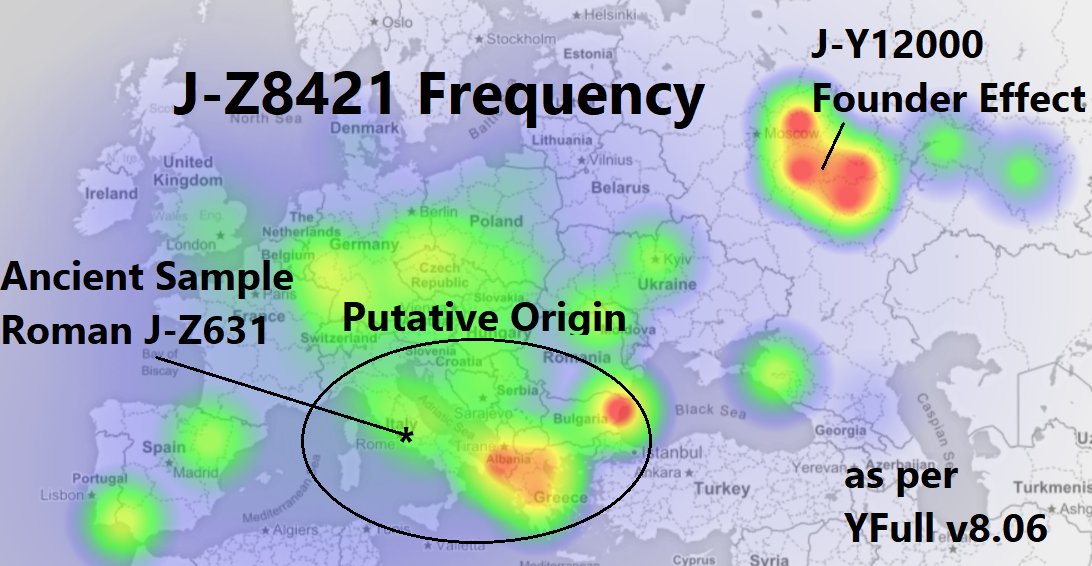J-Z8421 is one of two children of J-Z1295. The other child is J-Y21878. The most recent common ancestor of both children lived an estimated 4000 years ago.
Four hundred years later, around 1600 BC, J-Z8421 split into two lineages. One went on to live in Chieti, Italy today and the other became J-Z631.
Around 800 BC was a very significant period for J-Z631. At this time the most recent common ancestor of all J-Z631 lived, siring at least six lineages that continue to this day. One of these lineages was very prolific, J-Z1043, who, along with his sons and grandsons, in turn immediately sired successive lineages of their own.
Since the first J-Z1043 man was a close relative, who lived within several generations of J-Z631 (having accumulated two SNPs), their geographic origins cannot be understood completely independent from one another.
This is why I've created a heatmap showing the relative frequencies of all men descended from the J-Z8421 man who are on the YFull tree, as of v8.06.

Keep in mind that frequency maps will show a high frequency for lineages that had a "founder effect", meaning one man who lived later had many many children. The children of one man alone drive up the total haplogroup frequency in a particular area. Despite having a higher overall frequency, such areas are likely not representative of the true origin of the haplogroup when no other lineages of the ancestors are found there.
In the map above, J-Y12000 has a founder effect visible around Mordovia, Russia. This isn't the origin of J-Z8421, but one man descendant of J-Z8421>Z631>Z1043>Z8424>Z8429>Y12007 migrated there sometime before 1200 years ago and had at least three sons at that time.
There are many additional samples who, based on individual SNP testing or STR matches, are also J-Z8421. However, I cannot compute a heatmap using these samples because I do not know the total number of samples across all haplogroups tested in each specific region - this is necessary to compute a frequency heatmap.
While this heatmap is based on a relatively small number of samples (only NGS tests) which were not chosen randomly via a scientific method, I still believe it is of some value.
One takeaway is that the relatively larger number of samples in the tree from England, Germany, Poland and the Czech Republic, when regional sampling rates are taken into account, do not yield higher frequency than parts of the Balkans.
Though there is significant frequency and diversity in the Rhein area of Germany and Bohemia that must be reckoned with.
Ancient Roman J-Z631 Sample
The single ancient sample of J-Z8421 is Z631+, found in a necropolis in Rome dated to 1-200 AD. The archaeologists described him as "Roman" based on burial context and his autosomal DNA was found to have a significant western European component. This last bit does not mesh exactly with an Italian or Balkan origin but by this time Rome was a cosmopolitan place where people from many parts of the empire mixed. Autosomal DNA reflects DNA from all ancestors and by the time of this man's burial, there may have been 32 generations since J-Z631 (given 25 years per generation).
More NGS Samples Coming Soon
The J-Z1043 Research Fund is testing several men that look to represent ancient branching points within J-Z631 and J-Z1043 lineages.
Three men in J-Z1043>FGC55778 recently purchased their own NGS tests and the results should come within the next months. So we will have our first J-Z1043 men tracing descent to Sicily and Western Macedonia (Greece) and a second Belgian.
NGS means Next Generation Sequencing test. It is the general term referring to Y SNP discovery tests like Whole Genome Sequencing and Big Y tests that advance research by establishing new lineages on the tree. Big Y is not the only test that does this, and now that FTDNA charges $99 to access your BAM file it becomes a less attractive offer for those wishing to do the YFull analysis which we value for our research. We value the geographic specificity of the samples in the YFull tree, the ancient samples, samples from scientific studies and the samples from all vendors. Particularly vital for our research into theoretical ancient migrations are the estimated dates for the most recent common ancestors of each lineage that only the YFull analysis provides.
We will use the research fund to partially fund affordable WGS tests for two men from western Slovenia, one who is J-Z631(xZ1043) and one who is J-Z1043>FGC55778>BY177422.
A man from Cres, an island of Croatia, I believe may form an ancient lineage of J-Z1043 with a basal sample on the YFull tree. He is a candidate for the third test we will fund.
I will be happy to spend more time theorizing on more regionally specific origin theories for J-Z1043, J-Z631 and their child lineages after this round of testing finishes and if we have enough funding to help us uncover additional materially significant discoveries through testing.
Your donation to the J-Z1043 Research Fund would advance research into the ancient origins of J-Z1043 and J-Z631.
Hi Hunter,
Fascinating results yet again. Thank you.
Nick